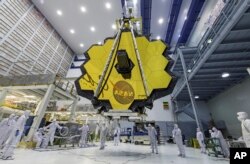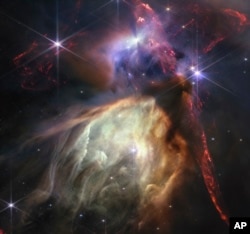Astronomers say they have identified the most distant, active supermassive black hole ever observed.
The observation came from data collected by the James Webb Space Telescope, which the American space agency NASA operates.
Researchers said the newly discovered black hole is at the center of a galaxy called CEERS 1019. The galaxy is estimated to have existed about 570 million years after the Big Bang. The Big Bang is the explosion many scientists believe created the universe. Scientists estimate the Big Bang happened around 14 billion years ago and was followed by a period of intense development across the universe.
Steven Finkelstein is an astronomer at the University of Texas at Austin who helped lead the research. He told The Associated Press that Webb has already observed other black holes that appear to be even closer to the Big Bang. But those findings are still being studied. The latest study results have been accepted for publication in the Astrophysical Journal Letters.
The black hole was observed in February by imaging and data instruments built into the Webb. Researchers say it is on the smaller side, about 9 million times the mass of our sun. That is smaller than any black hole yet identified in the early universe, the team said.
Researchers say signals from the observed black hole are weak so more observations will be needed to confirm the findings.
Finkelstein said there are numerous non-active black holes, some of which are even more distant than the one observed. But without any observable gas, they cannot be identified.
The team also used the Webb to study two other small black holes from the early universe. These objects dated back to around 1 billion years after the Big Bang. The observations suggest these smaller black holes may have been more common as the universe began to develop.
“There are probably many more hidden little monsters out there waiting to be found,” said Dale Kocevski. He was part of the research team, representing Colby College in Maine.
Launched in late 2021, NASA’s Webb is the largest, most powerful telescope ever sent into space. Its first images and science results were released by NASA about one year ago.
The Webb is a large infrared telescope designed to gather more in-depth data and explore parts of space never observed before. The device collects infrared waves --electromagnetic energy that cannot be seen with the human eye. Infrared waves pass through gas and dust that can hide objects in space. The infrared system can also show light from more distant parts of the universe.
NASA recently celebrated the Webb’s one-year anniversary by releasing a new image observed by the telescope. The image shows 50 baby stars in a cloud collection about 390 light-years from Earth. A light-year is 9.7 trillion kilometers.
The image shows an area of space that is full of bright hydrogen gases and dense collections of dust. All the young stars appear to be no bigger than our sun. Scientists said it is a good image of this brief period in a star’s life.
NASA program scientist Eric Smith told the AP about the image: “It’s like a glimpse of what our own system would have looked like billions of years ago when it was forming.”
I’m Bryan Lynn.
The Associated Press, the University of Texas at Austin and NASA reported on this story. Bryan Lynn adapted the reports for VOA Learning English.
__________________________________________________________________
Words in This Story
supermassive – adj. used to describe something that has an extremely large mass
monster –n. a horrible imaginary creature
glimpse – n. to see something or someone for a very brief moment
______________________________________________________________________
What do you think of this story? We want to hear from you. We have a new comment system. Here is how it works:
- Write your comment in the box.
- Under the box, you can see four images for social media accounts. They are for Disqus, Facebook, Twitter and Google.
- Click on one image and a box appears. Enter the login for your social media account. Or you may create one on the Disqus system. It is the blue circle with “D” on it. It is free.
Each time you return to comment on the Learning English site, you can use your account and see your comments and replies to them. Our comment policy is here.











Forum